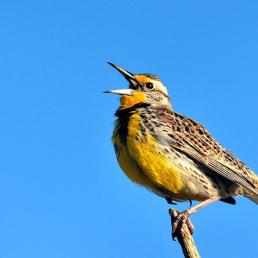

Join BirdNote tomorrow, November 30th!
Illustrator David Sibley and actor H. Jon Benjamin will face off in the bird illustration battle of the century during BirdNote's Year-end Celebration and Auction!
Almost half of all migratory shorebirds nesting in North America migrate through the Cheyenne Bottoms Wildlife Area in central Kansas. Almost all of the continent's Wilson's Phalaropes rest and refuel at the wetlands here. The birds fly a great oval route. In autumn, in the East, they head from Canada and the Arctic, across the Maritimes and New England, and south down the coast. Then in spring, when shallow wetlands on the Great Plains "bloom" with invertebrates, they fly north through the heartland of the country. Wetland conservation protects stopover points for these and other birds.
Support for BirdNote comes from the Cornell Lab’s Bird Academy, with online courses for people of all knowledge levels. More at AllAboutBirds.org.
BirdNote®
Shorebirds in Kansas
Written by Todd Peterson
This is BirdNote.
[American Golden-Plover call]
Almost half of all migratory shorebirds nesting in North America, including the American Golden-Plover we’re hearing, migrate through the Cheyenne Bottoms Wildlife Area in central Kansas.
Shorebirds in Kansas?
[American Golden-Plover call]
Yes. Almost all of the continent’s Wilson’s Phalaropes [call of Phalaropus tricolor], Long-billed Dowitchers [call of Limnodromus scolopaceus], and White-rumped, Baird’s and Stilt Sandpipers [Calidris fuscicollis, C. bairdii and C. himantopus] rest and refuel at the wetlands here. [Stilt Sandpipers] That’s more than half a million shorebirds representing 40 species that stop at the site during spring migration. [Flocks of Stilt Sandpipers calling]
But aren’t they birds of the coast?
Well, it turns out they’re flying a great oval route, making use of what nature provides. In autumn, with their long wings and rapid flight, they take advantage of favorable winds. In the East, they head from Canada and the Arctic, across the Maritimes and New England, and south down the coast. Then in spring, when shallow wetlands on the Great Plains “bloom” with invertebrates, they fly north through the heartland of the country.
So for good reason, these marshes have been designated wetlands of international importance. Far from the coast, shorebirds find here what they need. [Stilt Sandpipers calling]
I’m Michael Stein.
Support for BirdNote comes from the Cornell Lab’s Bird Academy, with online courses for people of all knowledge levels. More at All About Birds dot org.
###
Sounds of the birds provided by The Macaulay Library of Natural Sounds at the Cornell Lab of Ornithology, Ithaca, New York. American Golden-Plover recorded by Gerrit Vyn; Sandpipers recorded by Wilson’s Phalarope by R.C. Faucett; Long-billed Dowitchers by C.A. Sutherland; Stilt Sandpiper by Gerrit Vyn. Ambient drawn from Wilson’s Phalarope recording.
Producer: John Kessler
Executive Producer: Chris Peterson
© 2014 Tune In to Nature.org May 2014/2016/2021 Narrator: Michael Stein
ID# SotB-shorebird-01-2011-05-19
Reference: A Directory of Wetlands of International Importance. Ramsar Information Sheet. Ramsar Site 411.







